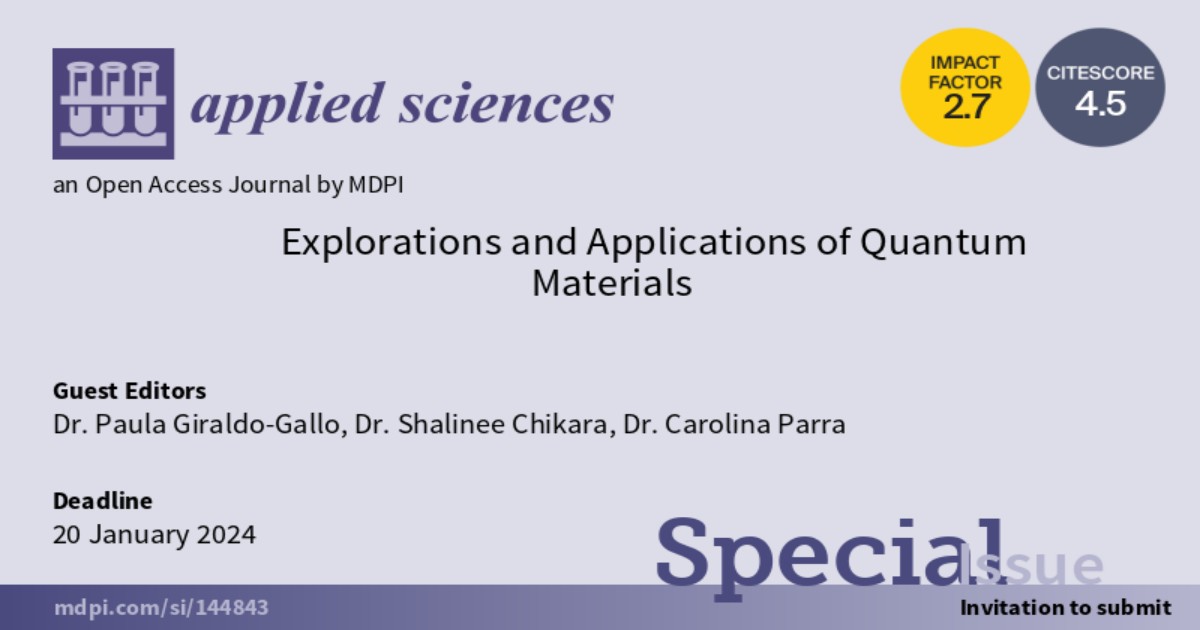Explorations and Applications of Quantum Materials
A special issue of Applied Sciences (ISSN 2076-3417). This special issue belongs to the section "Materials Science and Engineering".
Deadline for manuscript submissions: closed (20 January 2024) | Viewed by 2490

Special Issue Editors
Interests: condensed matter physics; strongly correlated systems; single crystal synthesis; materials under extreme conditions (low temperatures, ultra-high magnetic fields); thermoelectric materials; optoelectronics in low-dimensional compounds; topological insulators and Weyl semimetals; unconventional superconductors; charge density wave systems; resonant ultrasound spectroscopy of quantum materials; quantum criticality in materials
Interests: condensed matter physics; strongly correlated electrons; complex oxides; emergent properties in quanum materials; multiferroics; magetoelectrics in metal organic systems; ferroelectrics; spin-liquids; frustrated magnetism; materials under extreme conditions; topological insulators; Weyl semimetals; spin-orbit coupling; iridates; quantum materials synthesis
Interests: nanotechnology; condensed matter physics; applied nanobiomaterials; nanostructured topological insulators; Weyl semimetals; local electronic properties, two-dimensional materials; heterostructures; superconductors; emergent ordering in complex materials; low temperature local probes
Special Issue Information
Dear Colleagues,
The field of quantum materials embraces materials that show properties emerging from strong electronic correlations and/or from the geometrical properties of electronic wavefunctions. In these systems, the competition of several low-energy states leads to novel emergent ground states and rich phase diagrams, posing interesting questions not only relating to our understanding of the fundamental physics of many body systems, but also to the possibility of new applications in highly efficient electronic and optical devices, as well as quantum computing. These include magnetic materials, multiferroics, superconductors, charge density wave compounds, topological insulators, Weyl semimetals, low-dimensional compounds and heterostructures, and disordered metals, among others.
This Special Issue, entitled “Explorations and Applications of Quantum Materials”, looks to highlight recent and original developments including, but not restricted to, the following topics: the fabrication of new quantum materials; the optimization of their diverse physical, electronic, and chemical properties; the exploration and characterization of phase diagrams and/or novel electronic ground states; the fabrication and characterization of devices based on these materials; and the calculation and prediction of new properties and applications.
Dr. Paula Giraldo-Gallo
Dr. Shalinee Chikara
Dr. Carolina Parra
Guest Editors
Manuscript Submission Information
Manuscripts should be submitted online at www.mdpi.com by registering and logging in to this website. Once you are registered, click here to go to the submission form. Manuscripts can be submitted until the deadline. All submissions that pass pre-check are peer-reviewed. Accepted papers will be published continuously in the journal (as soon as accepted) and will be listed together on the special issue website. Research articles, review articles as well as short communications are invited. For planned papers, a title and short abstract (about 100 words) can be sent to the Editorial Office for announcement on this website.
Submitted manuscripts should not have been published previously, nor be under consideration for publication elsewhere (except conference proceedings papers). All manuscripts are thoroughly refereed through a single-blind peer-review process. A guide for authors and other relevant information for submission of manuscripts is available on the Instructions for Authors page. Applied Sciences is an international peer-reviewed open access semimonthly journal published by MDPI.
Please visit the Instructions for Authors page before submitting a manuscript. The Article Processing Charge (APC) for publication in this open access journal is 2400 CHF (Swiss Francs). Submitted papers should be well formatted and use good English. Authors may use MDPI's English editing service prior to publication or during author revisions.
Keywords
- magnetic materials
- spintronic devices
- spin liquids and frustrated magnets
- ferroelectrics
- piezoelectrics
- multiferroics
- metal-to-insulator transitions
- charge density wave compounds
- electronic nematic systems
- high-temperature superconductors: cuprates and pnictides
- heavy fermion superconductors
- room temperature superconductivity
- superconductivity and other correlated states in twisted-bilayer graphene and other moirè heterostructures
- superconductivity in disordered metals
- organic superconductors
- topological insulators
- Weyl semimetals
- topological quasiparticles
- transition metal chalcogenides
- complex oxides
- nanostructures of quantum materials
- optoelectronic devices and materials
- photovoltaic devices and materials
- quantum materials under extreme conditions
- quantum materials synthesis
- quantum materials for biological applications
Benefits of Publishing in a Special Issue
- Ease of navigation: Grouping papers by topic helps scholars navigate broad scope journals more efficiently.
- Greater discoverability: Special Issues support the reach and impact of scientific research. Articles in Special Issues are more discoverable and cited more frequently.
- Expansion of research network: Special Issues facilitate connections among authors, fostering scientific collaborations.
- External promotion: Articles in Special Issues are often promoted through the journal's social media, increasing their visibility.
- e-Book format: Special Issues with more than 10 articles can be published as dedicated e-books, ensuring wide and rapid dissemination.
Further information on MDPI's Special Issue policies can be found here.





